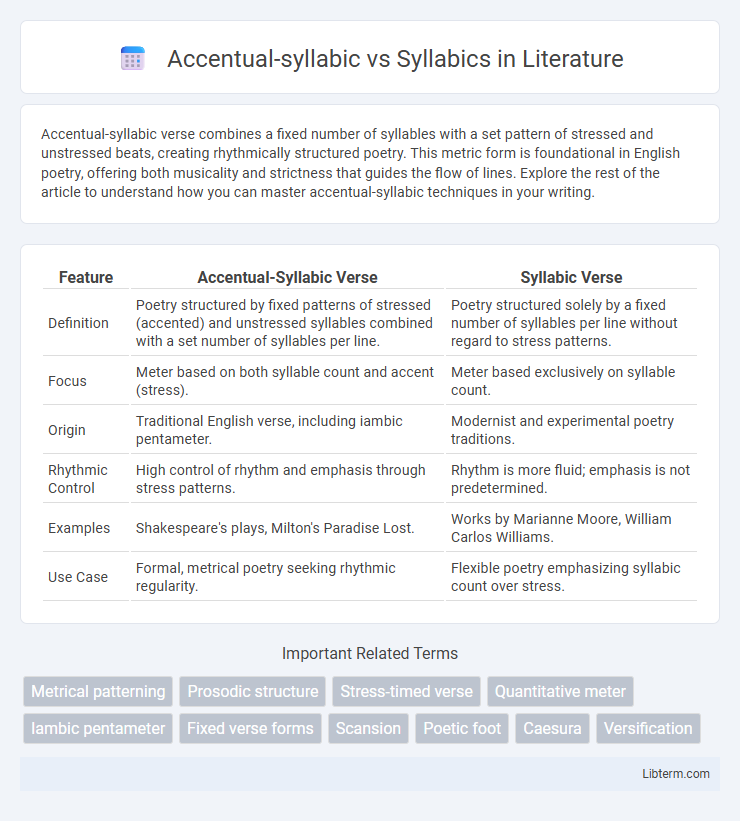Accentual-syllabic verse combines a fixed number of syllables with a set pattern of stressed and unstressed beats, creating rhythmically structured poetry. This metric form is foundational in English poetry, offering both musicality and strictness that guides the flow of lines. Explore the rest of the article to understand how you can master accentual-syllabic techniques in your writing.
Table of Comparison
| Feature | Accentual-Syllabic Verse | Syllabic Verse |
|---|---|---|
| Definition | Poetry structured by fixed patterns of stressed (accented) and unstressed syllables combined with a set number of syllables per line. | Poetry structured solely by a fixed number of syllables per line without regard to stress patterns. |
| Focus | Meter based on both syllable count and accent (stress). | Meter based exclusively on syllable count. |
| Origin | Traditional English verse, including iambic pentameter. | Modernist and experimental poetry traditions. |
| Rhythmic Control | High control of rhythm and emphasis through stress patterns. | Rhythm is more fluid; emphasis is not predetermined. |
| Examples | Shakespeare's plays, Milton's Paradise Lost. | Works by Marianne Moore, William Carlos Williams. |
| Use Case | Formal, metrical poetry seeking rhythmic regularity. | Flexible poetry emphasizing syllabic count over stress. |
Introduction to Accentual-Syllabic and Syllabics
Accentual-syllabic verse relies on a fixed pattern of stressed and unstressed syllables, creating rhythmic meters like iambic pentameter used extensively in English poetry. Syllabic verse, by contrast, counts only syllables per line without regard to stress, as seen in traditional Japanese haiku and modern experimental poetry. Understanding these distinctions is essential for analyzing meter and rhythm in diverse poetic traditions.
Historical Origins of Poetic Meter
Accentual-syllabic meter originated in Old English poetry, characterized by a fixed number of stressed syllables per line combined with a precise total syllable count, evolving prominently during the Middle Ages in English verse. Syllabic meter, rooted in Romance languages like French and Japanese, depends solely on counting syllables per line without stress patterns, reflecting linguistic traditions where syllable quantity shapes rhythm. The historical divergence between these meters highlights the influence of language phonology on poetic form, with accentual-syllabic meter aligning with stress-timed languages and syllabics with syllable-timed languages.
Defining Accentual-Syllabic Verse
Accentual-syllabic verse is defined by its strict pattern of both stressed and unstressed syllables, creating a fixed rhythm based on the number of syllables and the arrangement of accents in each line. This metrical form contrasts with syllabic verse, which relies solely on counting syllables without regard to stress patterns. The precision in accentual-syllabic verse allows poets to craft rhythm and musicality through structured patterns such as iambic pentameter or trochaic tetrameter.
Understanding Syllabic Verse
Syllabic verse centers on counting the exact number of syllables per line, making syllable quantity the primary structural element, unlike accentual-syllabic verse which balances both syllable count and stress patterns. Understanding syllabic verse requires recognizing its emphasis on syllable precision, often leading to varied rhythmic patterns free from consistent stress accents. This form is prevalent in languages with consistent syllable timing, highlighting the distinction from the stress-timed, accentual-syllabic tradition.
Core Differences Between Accentual-Syllabic and Syllabics
Accentual-syllabic meter combines both stressed and unstressed syllables in a fixed pattern, creating rhythm through the interplay of stress and syllable count, typical in forms like iambic pentameter. Syllabic meter counts only the number of syllables per line without regard to stress, focusing on syllable count uniformity as seen in haiku or certain modern poetry. The core difference lies in accentual-syllabic poetry's reliance on stress patterns for rhythm, whereas syllabic poetry depends solely on syllable quantity, making stress irrelevant.
Key Examples in English Poetry
Accentual-syllabic verse, exemplified by Shakespeare's sonnets, relies on patterns of stressed and unstressed syllables within a fixed number of syllables per line, creating rhythmic regularity. Syllabic verse, seen in the poetry of Marianne Moore, counts the number of syllables per line regardless of stress, allowing varied and unconventional rhythms. These distinct approaches highlight differences in English poetic structure, with accentual-syllabic emphasizing meter and syllabics emphasizing syllable count.
Strengths of Accentual-Syllabic Forms
Accentual-syllabic verse excels in its precise control over both stress patterns and syllable counts, enabling rhythmically consistent and melodically appealing poetry. Its structured form allows poets to create nuanced variations within a predictable metrical framework, enhancing emotional impact and memorability. This dual emphasis on accent and syllable facilitates rich, versatile expression that aligns closely with natural speech patterns while maintaining artistic discipline.
Unique Features of Syllabic Poetry
Syllabic poetry uniquely emphasizes a fixed number of syllables per line, disregarding stress patterns that define accentual-syllabic verse. This form allows for rhythmic flexibility while adhering strictly to syllable count, creating a distinct metrical structure. Its focus on syllable quantity rather than stress introduces varied pacing and musicality unattainable in traditional accentual-syllabic meters.
Challenges in Writing and Analyzing Each Type
Accentual-syllabic verse requires strict adherence to metrical patterns involving stressed and unstressed syllables, posing challenges in maintaining natural language flow while meeting rhythmic constraints. Syllabic verse focuses solely on syllable count per line without stress patterns, which can complicate expressive nuances and lead to ambiguity in rhythm interpretation. Writers and analysts must navigate these complexities to balance structural discipline with emotional depth and clarity.
Choosing the Right Meter for Creative Expression
Choosing the right meter for creative expression involves understanding the nuances of Accentual-syllabic and Syllabic verse forms. Accentual-syllabic meter, emphasizing both stress patterns and syllable counts, suits traditional poetic structures like sonnets and blank verse, providing rhythmic precision and emotional impact. Syllabic meter, focusing solely on syllable count without stress considerations, offers flexibility and modernist freedom, ideal for experimental poetry and nuanced tonal variations.
Accentual-syllabic Infographic

 libterm.com
libterm.com